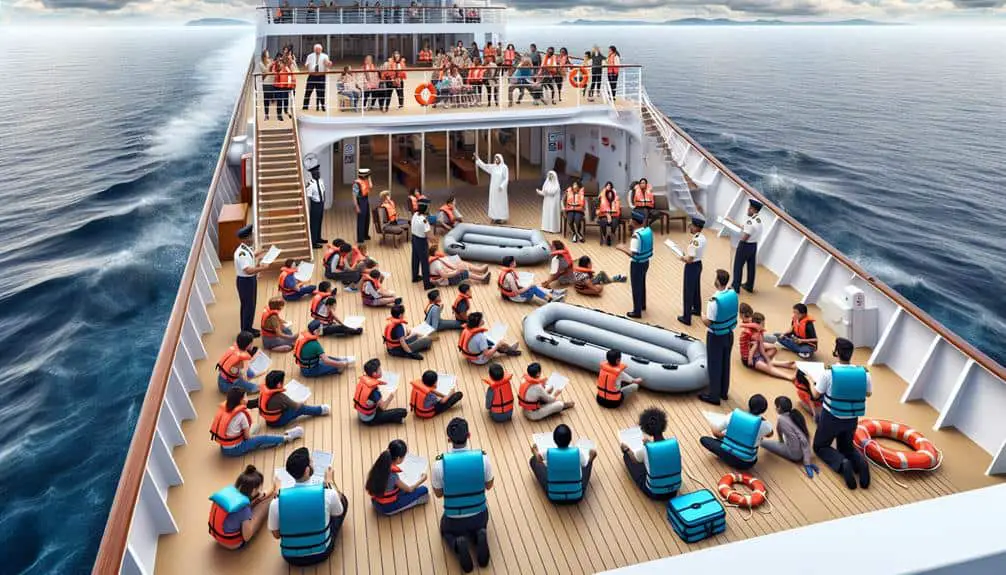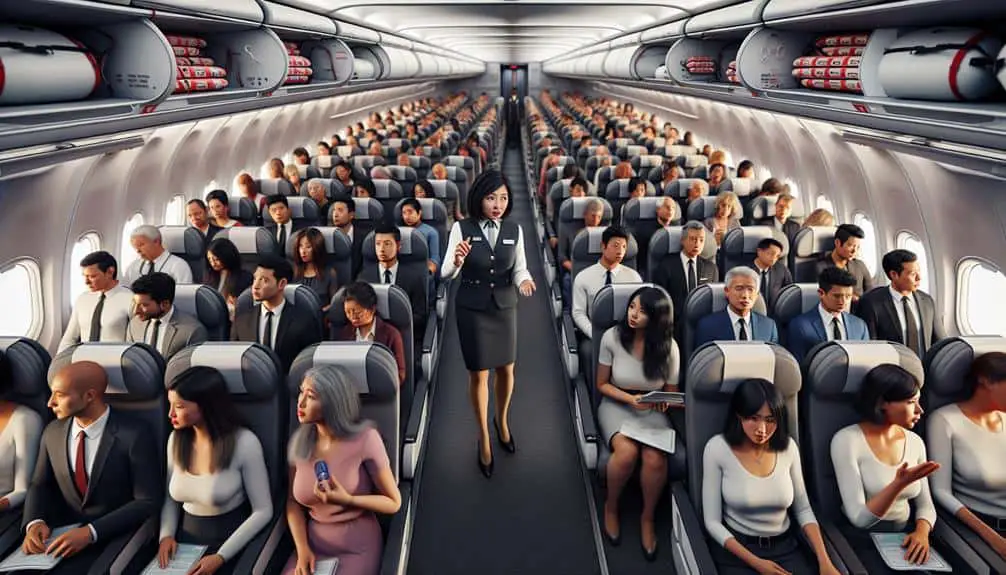Guarantee your safety on cruises with strong emergency response plans. Key players, like the Captain and Medical Team, are trained for swift actions during crises. Crew members undergo rigorous training and drills to handle emergencies effectively. Seamless communication systems aid coordination in critical situations. Regular reviews and updates keep procedures current and enhance safety measures. Learn how high-quality planning and trained personnel ensure your well-being in emergencies.
Key Points
- Robust emergency response plans are essential for safety and well-being on cruises.
- Regular training and drills ensure crew readiness for various emergency scenarios.
- Seamless communication systems are crucial for effective coordination during crises.
- Incident command structure with key players like the Captain and Safety Officer is vital.
- Regular review and updating of procedures enhance emergency preparedness on cruise ships.
Importance of Emergency Response Plans
In ensuring the safety and well-being of passengers and crew, having robust emergency response plans is paramount on cruises. Emergency preparedness is the cornerstone of crisis management in the maritime industry. A thorough emergency response plan outlines procedures for various scenarios such as fires, medical emergencies, man overboard incidents, or severe weather conditions. It involves meticulous coordination between crew members, clear communication protocols, and well-defined roles and responsibilities.
Cruise lines must regularly conduct drills and training exercises to make sure all staff are well-prepared to handle emergencies efficiently. These exercises help in identifying gaps in the response plan, allowing for continuous improvement. Additionally, staying updated with the latest safety regulations and technological advancements is vital for enhancing emergency preparedness.
In the event of a crisis, swift and effective actions can make a significant difference in mitigating risks and ensuring the safety of everyone on board. Hence, investing time and resources in developing and regularly updating emergency response plans is a fundamental aspect of operating a safe and secure cruise environment.
Key Players in Emergency Response
Key players in emergency response aboard cruises are critical components of ensuring swift and effective crisis management. During emergencies, a well-defined incident command structure is essential. This structure typically includes key players such as the Captain, who ultimately holds responsibility for the ship and its passengers.
The Safety Officer plays a pivotal role in coordinating emergency procedures and ensuring compliance with safety regulations. The Medical Team is indispensable for providing immediate medical assistance to passengers and crew. The Security Team is responsible for maintaining order and ensuring the safety of everyone on board.
Additionally, the Guest Services Manager plays a crucial role in communicating with passengers and providing support during emergencies. Collaborating seamlessly, these key players form a cohesive team that can efficiently manage crises. Understanding the importance of each role and how they interconnect is fundamental to effective crisis management on cruises.
Training and Drills for Crew
To guarantee readiness and effectiveness in emergency situations, crew members aboard cruises undergo rigorous training and regular drills. Crew preparedness is a key priority, making sure that each member is equipped with the necessary skills to handle any potential crisis onboard. Hands-on practice plays a vital role in this training, allowing crew members to simulate real-life emergency scenarios and become proficient in their response.
During drills, crew members are trained in various emergency procedures such as fire drills, man-overboard scenarios, and medical emergencies. These drills are designed to test the crew's ability to react swiftly and efficiently in high-stress situations. By engaging in these exercises regularly, crew members can hone their skills and build confidence in their abilities to handle emergencies effectively.
Training sessions also cover topics such as crowd management, communication protocols, and evacuation procedures. Crew members receive detailed instructions on their roles and responsibilities during different emergency situations, ensuring seamless coordination during crisis events. Through continuous training and hands-on practice, cruise ship crews are well-prepared to respond to emergencies and guarantee the safety and security of all passengers onboard.
Communication Systems on Board
Ensuring seamless communication systems on board is vital for effective coordination during emergency situations on cruises. Emergency communication protocols and emergency alert systems should be in place to swiftly disseminate essential information to passengers and crew members. Communication channels must be robust, with redundant systems in case of failures. Regular testing and maintenance of these systems are crucial to guarantee their functionality when needed most.
Passenger communication plays an important role in keeping guests informed and calm during emergencies. Clear instructions on where to gather, what actions to take, and how to stay safe must be communicated promptly. Crew coordination is equally essential, with communication systems facilitating swift and organized responses to incidents onboard.
Training programs should include practice scenarios that test the effectiveness of communication systems under pressure. Regular drills can help identify weaknesses and areas for improvement. By prioritizing communication systems on board, cruise lines can enhance their emergency response capabilities and ensure the safety and well-being of everyone on the ship.
Review and Update Procedures
Regularly reviewing and updating procedures is vital for maintaining a high standard of emergency preparedness on cruise ships. To guarantee effective emergency response planning, it's essential to continuously update protocols in response to new threats, technological advancements, and lessons learned from past incidents. By staying proactive in this aspect, cruise lines can adapt swiftly to changing circumstances and enhance their overall safety measures.
One key aspect of reviewing and updating procedures is evaluating the effectiveness of training programs. Conducting regular appraisals of training effectiveness allows cruise ship operators to identify areas for improvement and address any gaps in knowledge or skills among crew members. This process ensures that the training provided remains relevant and impactful in preparing staff to respond efficiently to emergencies.
Frequently Asked Questions
What Measures Are in Place for Passengers With Disabilities During an Emergency Situation on a Cruise Ship?
During emergencies on cruises, passengers with disabilities have specific accommodations. Emergency evacuation procedures include trained staff assisting with mobility aids, accessible routes, and personalized plans. Safety drills guarantee preparedness for all guests.
How Does the Cruise Line Coordinate With Local Authorities in Different Ports to Ensure a Seamless Response to Emergencies?
To guarantee a seamless emergency response, your cruise line collaborates with local authorities in different ports. This partnership enhances emergency preparedness, response planning, and communication strategies, facilitating a swift and effective response to any unforeseen situations.
Are There Specific Protocols in Place for Responding to Medical Emergencies on Board, and How Are Medical Supplies Replenished During a Cruise?
In the event of a medical emergency onboard, the cruise ship's medical staff undergo rigorous training to guarantee a swift response. Emergency response drills and procedures are regularly practiced to confirm readiness. Supplies are replenished at various ports along the journey.
What Technology or Tools Are Used to Aid in Communication and Coordination During Emergencies at Sea?
During emergencies at sea, cutting-edge technology like satellite phones and emergency beacons guarantee swift emergency communication. Coordination tools such as centralized crisis response systems help streamline efforts, enhancing safety and rapid response on cruises.
How Does the Cruise Line Ensure the Safety and Security of Passengers and Crew During a Potential Evacuation Scenario?
In a potential evacuation scenario, the cruise line meticulously plans safety measures and evacuation procedures. Ensuring passenger and crew security is paramount. It's a strategic dance of preparation and vigilance, where every detail counts.




